Blankets from Alize Puffy yarn
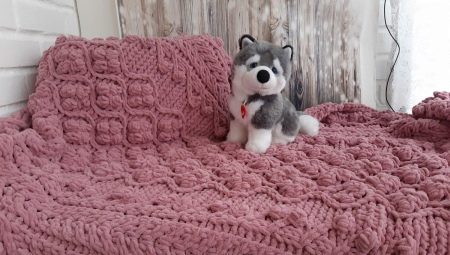
An ideal way to explore the world of knitting is to try to knit a simple item from Alize Puffy yarn. It is very simple to create from such fiber - the needleworker does not even need additional tools, only the desire to create and free time. In this article, we will explain what Alize Puffy yarn is and how to work with it.
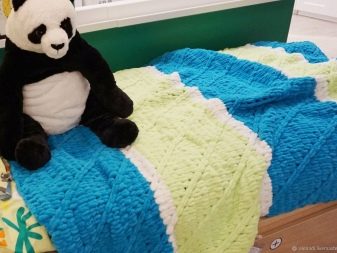
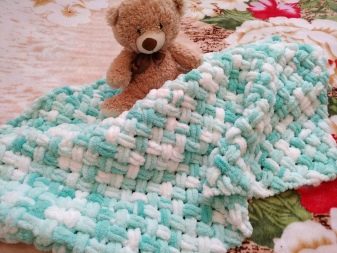
Features of the yarn
The yarn with the interesting name Alize Puffy has become a real breakthrough in knitting - the technology for producing yarn with ready-made loops was recently invented in Turkey. In a short period of time, innovative material has become a favorite subject for the creativity of many needlewomen, including beginners.
Alize Puffy differs from other types of yarn by an unusual characteristic - the plush material of the thread is made in the form of a chain of identical loops. The structure of the fiber does not require the use of a hook and knitting needles - the loops are knitted by hand. In addition, the fluffy thread is very soft and pleasant to the touch, so the knitting process becomes also relaxing.

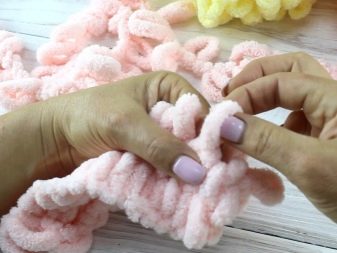
Weaving the details of the material together, craftsmen can create simple and intricate patterns using simple patterns or unusual weaving methods. There are many different techniques for creating blankets from an unusual thread, allowing you to bring the knitter's ideas to life.
The diverse palette of colors of these products is also very wide - everyone can find an interesting shade or create a multi-colored pattern from Alize Puffy Color yarn.
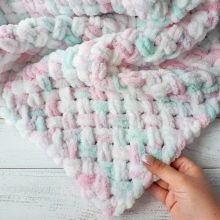
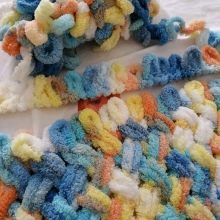
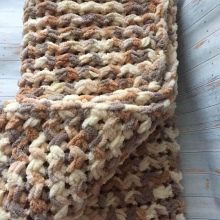
Calculation of the number of threads
Finding out the exact thread consumption is best done in practice by tying a small piece of fabric from one skein, and then measuring the resulting size of the product.Having created a small canvas with the selected pattern, count the number of loops involved in the work. Let's give an example of further calculation.
- Measure the width of the stitches at work. For example, let's take 18 loops with a width of 30 cm.
- To make a blanket 150 cm wide, make a proportion of the blanket width multiplied by the number of working stitches of the sample and divided by the width of the sample: 150 x 18: 30 = 90 stitches.
- After that, consider the repetitive knitting pattern and adjust the number of loops to fit it.
- Also, pay special attention to the strapping, calculating how many centimeters it takes. From the entire width of the canvas, subtract the strapping on each side and calculate the number of loops without it.
- Knit the length of the blanket until you reach the required size.
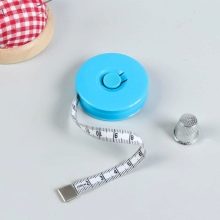
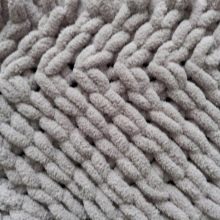

It is important to remember that the calculation of the number of threads depends entirely on how you plan to weave the buttonholes. The sizes of finished bedspreads vary greatly for the following knitting patterns:
- satin stitch - the consumption of material is minimal, so the product is large and economical;
- "Braided" - crossing the loops requires an average consumption of threads;
- "Braids" - complex patterns require a large amount of yarn, so it is necessary to purchase material with a margin.
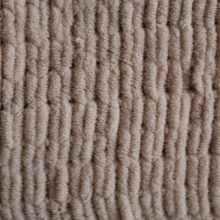


For people who are trying to knit on their own for the first time, it is best to start with the simplest pattern - satin stitch knitting, and also first try to make a small children's blanket. Intricate patterns and large bedspreads take longer and require a lot of effort, so they can discourage beginners from continuing to knit. Experienced needlewomen, who used to knit before using a crochet or knitting needle, can easily create a beautiful blanket with intricate patterns, because it is easier and faster to knit with your hands than with special tools.
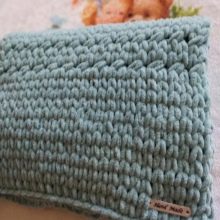
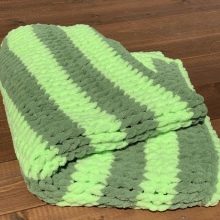
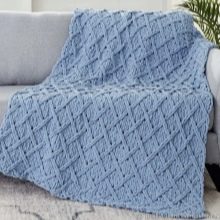
To calculate the required amount of material, you need to know the parameters of the yarn. Most often, Alize Puffy has the following characteristics:
- product packaging consists of 5 skeins, which are enough to create a satin stitch blanket measuring 80x80 cm;
- the standard weight of 1 skein is 100 grams;
- the length of the thread in a skein is 9 meters.

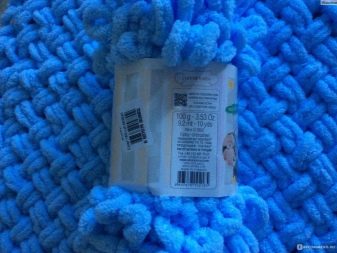
These parameters apply only to ordinary Alize Puffy yarns; for other types of yarns from this manufacturer, separate calculations must be made, because the length and density of the material are different.
We suggest that you familiarize yourself with ready-made calculations for knitting blankets for children and adults.
For baby product
It takes very little yarn to knit a baby plush blanket. Consider the consumption of material for knitting with stitch.
- For a newborn baby, a product measuring 80x80 cm is quite enough. To make such a blanket, you will need 5 skeins of Alize Puffy.
- For children from 3 to 5 years old, it is best to make a canvas with parameters 100x100 cm, using 6-7 skeins of yarn.
- For schoolchildren and adolescents, a product measuring 150x150 cm will be enough.To knit a blanket of this size, prepare 12 balls of thread with loops.
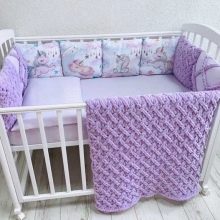
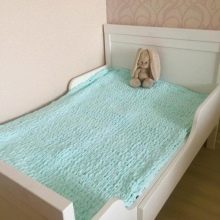
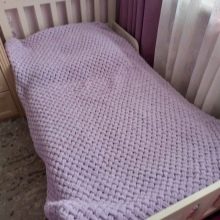
For an adult
It will take a lot more yarn and time to knit to create a large blanket for an adult. Large items require colossal efforts and inspiration, because they can be easily thrown into the far corner to other loose items, so it is better to first try to knit the item with satin stitch.
Let's take a closer look at the consumption of yarn for a large blanket:
- for a canvas with parameters 150x180 cm, you need to purchase 18 skeins of thread;
- a product measuring 180x200 cm requires 20 to 23 skeins of Alize Puffy, depending on the knitting density;
- a double blanket with parameters 190x200 cm assumes the use of 24-26 balls of yarn;
- To create a 200x200cm square plush blanket, you will need 5-6 packs of Alize Puffy, each containing 5 skeins of thread.

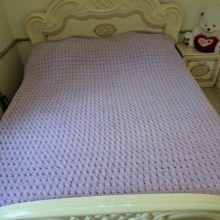
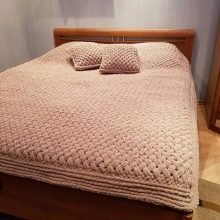
Color selection
The color palette of Alize Puffy yarns comes in a wide variety of shades, from standard white and black to unusual lavender and royal blue.In total, there are 34 different colors in the assortment of standard balls, but the manufacturers did not stop there either. You can also find Alize Puffy Color on sale - they have the same characteristics as ordinary threads, but they have three-color alternating loops. The multi-colored assortment of threads expands the possibilities of creating original blankets, because it includes 22 more types of shades.


To choose the right color for the blanket, it is enough to rely on your tastes or the tastes of the person to whom you are going to knit a cozy creation. The bedspread can be plain, multi-colored, or created from pieces of yarn of different colors.
We propose to consider multi-colored options for blankets.
- For girl. For a small child, it is better to choose light shades, for example: white or light yellow, powder or lavender. Also appropriate would be a multi-colored plaid from Alize Puffy Color, which combines a smooth transition from three tones.
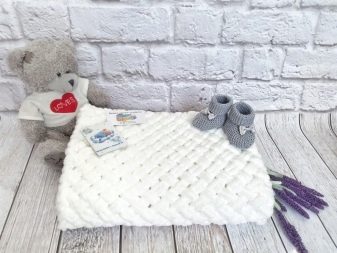
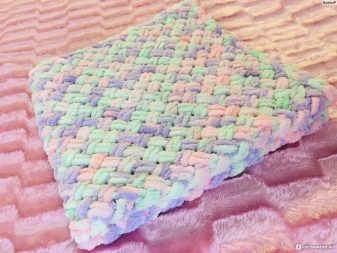
- For boy. The requirements for the color of the bedspread for the boy are the same as for the girl - it should not be too bright.
Blue, light turquoise and pistachio yarns are suitable.
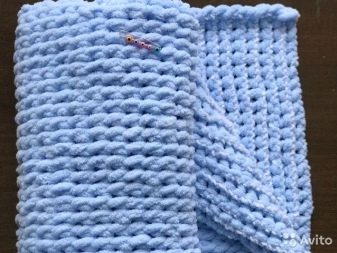
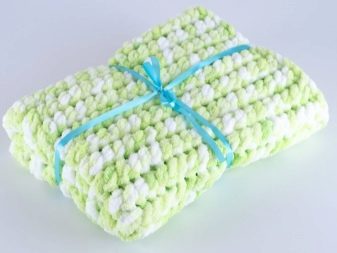
- For a teenager. School-aged kids are less sensitive to bright colors, so you can opt for richer hues like reds, peaches, royal blues, and plums. You can also experiment with two matching tangle colors to create a striped canvas.
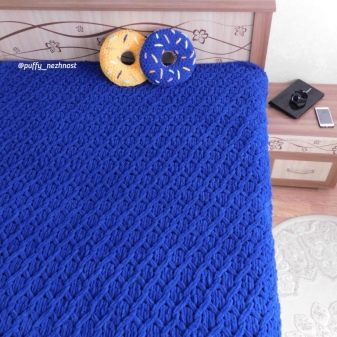
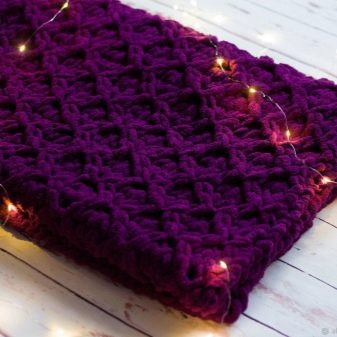
- For adults. In a wide range of shades of Alize Puffy, everyone will find a suitable color for themselves. In the palette of balls, there are both neutral shades (gray, white, black and beige melange) and quite bright, evocative colors (cornflower, pistachio, fuchsia and coral). From the assortment of threads, you can easily select the right Alize Puffy skeins so that the new bedspread will fit into the interior of the room.

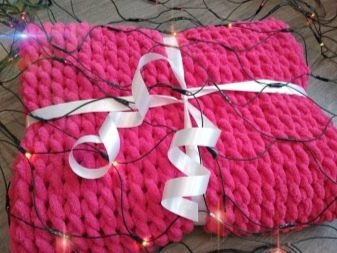
Description of knitting with different patterns
Despite the fact that Alize Puffy threads have appeared on sale quite recently, needlewomen have already tried various weave options and knitting patterns. For unusual yarn, the same knitting methods are suitable that are used for knitting, only the work is done with your fingers. The needlework method with looped thread is very simple, because the canvas does not need to be turned over - the whole process is carried out from one side.
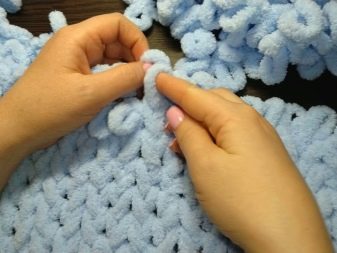
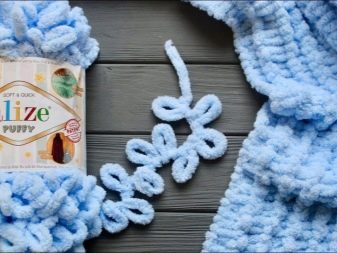
We propose to consider several ways of weaving: from the simplest method to the most complex option.
Face loops
Before work, determine what size the product will be and calculate the thread consumption by tying a small sample. To work, you need scissors and the required number of balls of thread. Next, step by step, follow the simple knitting method with the front loops.
- Lay out the thread from the first ball, taking into account the width of the future product and unfold all the loops up.
- Turn the thread and lay it parallel to the first thread with the ears down.
- Start knitting: thread the last loop of the lower row into the outer loop of the upper row. During work, make sure that the rings do not twist, otherwise the product will be heterogeneous.
- Pass all the loops of the first thread through the loops of the second thread, guiding the loose ones up to the end of the row.
- Then spread the third thread and repeat the method until you get the desired length of the product.
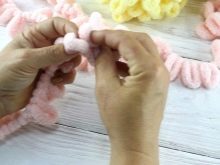
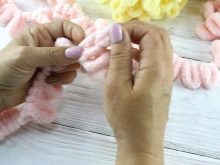
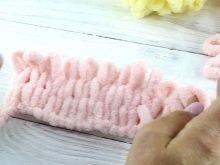
When the first tangle is over, cut the last eyelet to form a ponytail. Do the same with the first ring of the new ball and tie the ends together with a tight knot. Cut off the ends of the yarn and continue to weave in the same manner.
Having reached the required length, thread the remaining free loops into each other, starting from the left edge. After finishing the row, cut off the excess thread, leaving one extra loop. Cut the extra ring, thread it into the last loop of the closed row 2-3 times and cut off the tail. The end of the thread at the beginning of knitting must also be cut off. Plaid with front loops is ready.

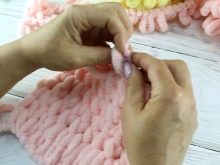
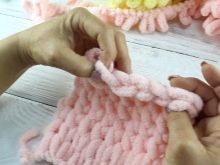
"Network"
A very unusual, dense and beautiful pattern is obtained by interweaving pairs of loops. To calculate the required number of skeins of thread, you need to apply a special formula - length x width x constant. The constant (constant number) for the braid pattern is the number of balls required to create a 100x100 cm canvas, and the number is 7.25.
To make a blanket 120x150 cm, translate the size of the product into meters and carry out the calculation using the formula above: 1.2 * 1.5 * 7.25 = 13.05. As a result, you will get the number of skeins of yarn required to make a blanket measuring 120x150 cm.However, buying 13 balls will hardly work out, so round the number to a larger value - 14 pieces. Consumption of material for creations of a different size is carried out in the same way, but this method is only suitable for a braided pattern.

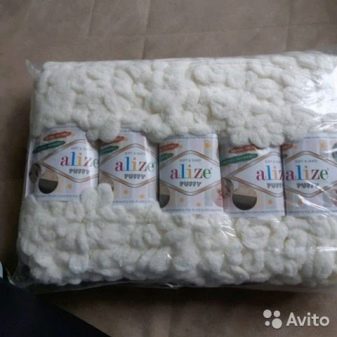
For the convenience of work, cut the first loop at the base so that a tail remains, which will later be neatly tucked into the blanket. Let's consider the step-by-step production of the "braid" pattern using the example of a blanket measuring 85x85 cm.
- On the buttonhole thread, count exactly 50 ears, then cross the last ring with the 49th loop so that there is a loop on top, looking towards the weave (from right to left). On the free part of the thread, grab the 51st and 52nd loops and thread them through the crossed rings 50 and 49, respectively. Gently pull 51 and 52 out onto the front of the belt and point up. The loops of the second row do not need to be crossed.
- Continue repeating the described manipulation to the end of the row, intertwining the paired rings. Do not forget to cross the ears of the lower row in the direction of weaving and level the loops so that they do not twist.
- Each next row will unfold in the opposite direction. To do this, leave the last working loop untouched and start crossing from the 2nd and 3rd working rings in the opposite direction to the previous row. Pass the two free-thread ears into crossed loops, repeating the method described above, but in the opposite direction (from left to right). As a result, at the end of the second row there will be one working loop - this is the 1st ring of the 3rd row.
- Cross the 1st eyelet of the 3rd row with the adjacent work loop, turning the pattern from right to left. Continue repeating the weaving as described above until you get the right length.
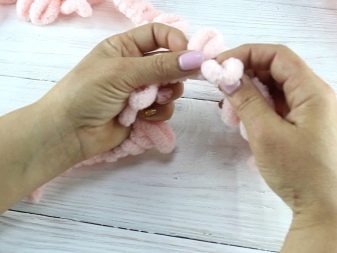
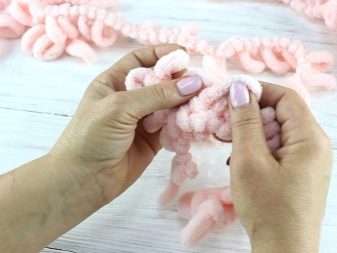
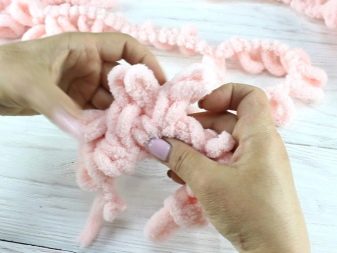
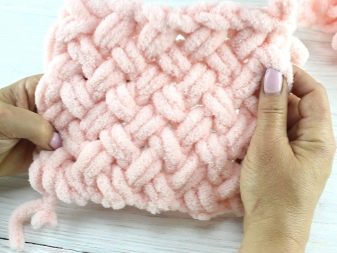
To complete the blanket, thread the free working ears into each other, starting at the edge opposite to the free thread.
To finish the job, cut off the excess thread, leaving one extra loop. Cut an additional eyelet at the base and thread the resulting ponytail through the last working ring. Cut or thread the loose thread into the pattern.
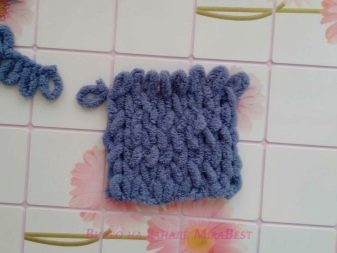
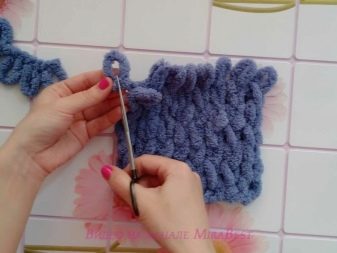
Braids
Another very interesting option for creating a plaid from plush yarn is the "braids" pattern. On the finished canvas, neat zigzags resembling pigtails are obtained. Such a blanket can be made for both a child and an adult.
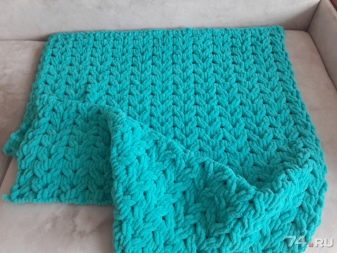
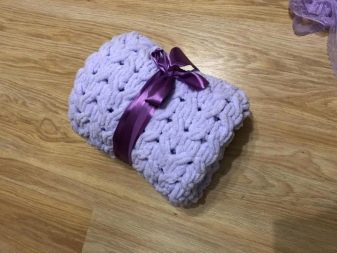
It will take a little more time, effort and attention to get the braid pattern, so as not to get confused in the alternation of patterns and the rotation of crossed loops. Before work, count an even number of rings along the width of the future bedspread.
- The first row is braided by simply threading the loops of the 2nd row through the ears of the 1st row without crossing or twisting.
- In the second row, the working loops must be crossed and the ears of the free thread must be passed through them, creating a pattern.
- The third row is knitted in the same way as the first - by simple knitting of loops. Then repeat the pattern until the canvas is of the required length.
Check the number of stitches after each knit row - there should be the same number as you counted for the first row. The end of knitting occurs in the same way as in the previous methods: the ears are knitted into each other, and the last free loop secures the weaving.
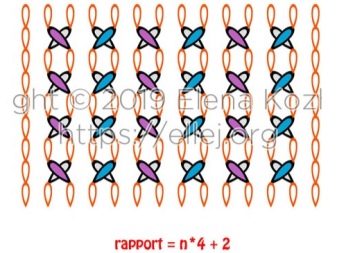
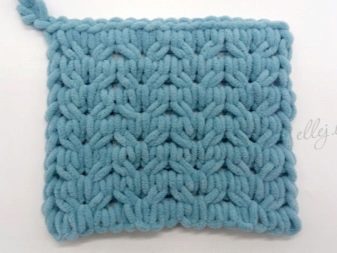
Hearts
Such a romantic pattern is best woven from yarns of different colors, alternating shades every two rows. Hearts are visible on a multi-colored blanket much better than on a plain garment. Another feature of the pattern is that it is knitted along the length of the bedspread, and not along its width. For this reason, the main thread must be measured by the length of the future blanket, and not by the width, as in the previous methods.
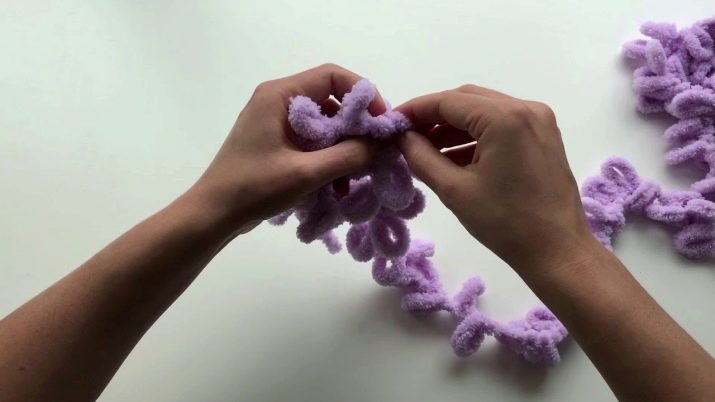
Consider a method for making a two-color heart pattern. For knitting, count an even number of loops corresponding to the required length of the product. Then follow the instructions.
- Cross the ears of the first thread from right to left and knit them with a free thread.
- In the second row, add another thread from the edge opposite the beginning of knitting. Cross the working threads and knit with the second color of the yarn.
- Add a loop of the first color to the last loop in the second row and knit them.
- Turn the second thread to the other side and knit a row, crossing the working threads and complementing them with free ears - this is the third row.
- The fourth row is again knitted with the first thread - cross the working loops and thread a free thread through them. Lift the last stitch in the row in the same way as in the second row when adding color.
- The fifth row is knitted in the opposite direction with the first thread. The pattern is repeated until the plaid is of the required width.
The heart pattern can be made from more colors, but in this situation it is necessary to cut and tie a new color every two rows.
For more information on how to knit a heart pattern, see the next video.
Rhombuses
To tie a diamond pattern, you need to carefully plan the course of work, calculate the consumption of materials and draw up a diagram for your size. Drawing with rhombuses is rather complicated and therefore not suitable for beginners.
One rhombus is created on the canvas by sequential knitting of loops in a clear sequence. The pattern will be completed only after knitting 6 rows. Before starting work, be sure to try making a pattern on a small sample.


How to care for a blanket?
If not properly cared for, a knitted blanket can lose its silky, soft texture, so there are a few simple rules to follow when washing and drying. Let's take a closer look at caring for a loop yarn bedspread.
- Washing. It is best for a blanket made from Alize Puffy to be hand washed at a water temperature not exceeding 30 degrees. However, if you plan to wash a large canvas, it will be too difficult to do it by hand. In such a situation, you can wash the product in a machine at a temperature of 30 degrees with the spin turned on at low revolutions.
- Household chemicals. Use delicate liquid detergents to keep the fibers soft. You can increase the effectiveness of the composition used by using a conditioner, and it is not recommended to add bleach while cleaning the blanket.
- Drying. Knitted fabrics must be dried horizontally so that they do not deform. There will be no problems with children's products - just lay them out on the dryer. With a large blanket, things are more complicated, but after spinning in the washing machine, it becomes almost dry. Due to the fact that very little moisture remains in the fibers, a large canvas can be rolled up 2-3 times and also laid out on the dryer, only periodically changing its position.
- Ironing. If during the cleaning process the hand-made product is crumpled, do not rush to use the iron - it can burn the fibers of the yarn and spoil the weaving structure. It is necessary to iron the blanket with steam, without touching the iron to the surface of the creation from Alize Puffy.


Beautiful examples
A variety of patterns and colors allows you to bring to life the most unexpected and daring ideas for making blankets. We suggest considering several beautiful options for creating a plaid from Alize Puffy yarn.
- Pattern "Marshmallow". Soft, plush yarn is very similar to the touch of a bouncy marshmallow, the similarity will be even stronger if you make the appropriate pattern.
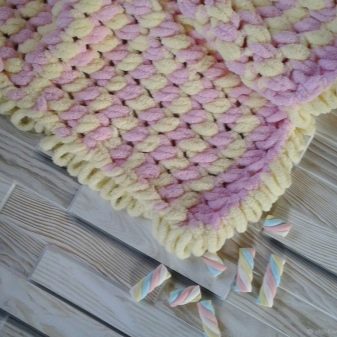

- Combination of pattern and binding. To give a small baby blanket a new life after the baby has grown, you can tie the edges with an additional Alize Puffy cloth.
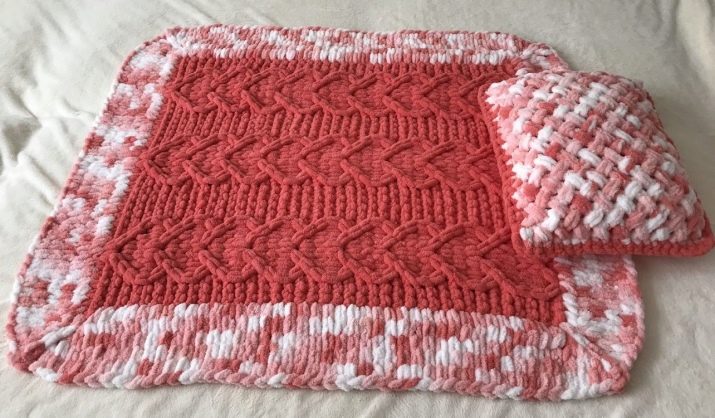
- Striped bedspread. Products from two contrasting colors or several shades, similar in tone, look interesting.
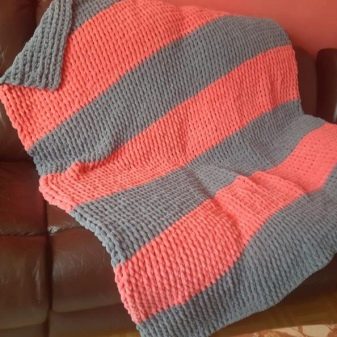
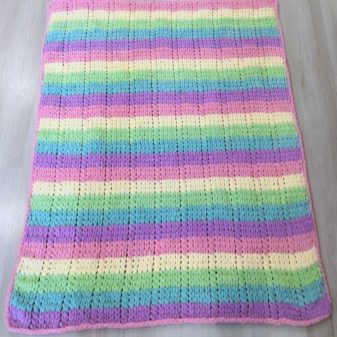
To learn how to knit a blanket from Alize Puffy yarn with your own hands, see the next video.








